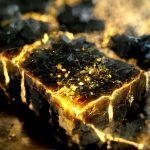
Table of Contents
The Rich History of Gold Leaf and Gilding
Gold has been treasured and coveted for centuries, with evidence of its use in jewelry, coins, and decorative arts dating back to ancient civilizations. The process of applying thin sheets of gold, known as gold leaf or gilding, dates back to early Egyptian and Mesopotamian cultures. The use of gold leaf in the Byzantine Empire led to the development of the technique of icon painting, where gold was used to depict divine light. The Renaissance saw a renewed interest in gold leaf and gilding, with elaborate decorations adorning religious and secular objects. In more recent times, gold leaf has been used in art deco design and contemporary installations. The rich history of gold leaf and gilding is a testament to the enduring allure of this precious material.
From Ancient Times to Contemporary Applications
Gold leaf and gilding techniques have been used throughout history and continue to be utilized in contemporary art and architecture. For example, Gustav Klimt’s famous painting “The Kiss” from the early 20th century features extensive gold leaf. In architecture, gilding can be seen in the gilded dome of St. Paul’s Cathedral in London and the gold leaf art deco ornamentation of the Chrysler Building in New York City. Gold leaf and gilding techniques have been adapted to different styles and mediums, from traditional paintings to modern installations, and continue to inspire artists and designers today.
The Process of Applying Gold Leaf
The process of applying gold leaf is delicate and time-consuming but results in a beautiful and reflective finish. First, a surface is prepared by sanding and applying a layer of adhesive, called size. The gold leaf is then applied by laying a sheet over the surface and gently pressing it into the size. The excess gold leaf is brushed away, and the surface is buffed to a shine. Additional layers of gold leaf can be added to create a more opaque finish. The application of gold leaf requires great skill and patience but the result is a luxurious and stunning effect.
Gilding Techniques for Different Surfaces
Different materials require different gilding techniques to achieve the desired result. Porous surfaces like wood or stone require a coat of primer before the size is applied to ensure the gold leaf adheres properly. Metal surfaces may require a different adhesive, or the use of heat to fuse the gold leaf to the surface. Glass or plastic surfaces can also be gilded with special adhesive or electroplating techniques. Choosing the right technique depends on the surface and the desired effect, and a skilled gilder can advise on the best approach.
The Versatility of Gold in Art and Architecture
Gold leaf and gilding can be used in a variety of artistic and architectural applications. In art, gold leaf can be used to draw attention to certain parts of a composition or to create a sense of opulence and luxury. In architecture, gilding can be used to highlight intricate details or to make a building stand out. Gold leaf can be used in religious art and architecture to evoke a sense of the divine or to symbolize the richness of the faith. With its ability to add depth and richness to any surface, gold leaf is a versatile material that can be used in a variety of ways.
The Symbolism of Gold in Society and Culture
Gold has symbolized wealth, prestige, and power for millennia. The rarity and allure of gold have made it a powerful status symbol, and it has been used to demonstrate wealth and influence throughout history. The use of gold in religious art and architecture highlights its association with the divine and spiritual power, while in other cultures, gold is used to symbolize good luck, prosperity, and fertility. The symbolism of gold adds another layer of meaning to the use of gold leaf and gilding techniques in art and architecture.
Caring for and Maintaining Gold Leaf and Gilded Surfaces
Gold leaf and gilded surfaces require special care to maintain their appearance. Gold is a soft metal and can be easily scratched or damaged if not protected properly. Gilded surfaces should be dusted regularly with a soft, dry cloth and can be cleaned with a damp cloth if necessary. Harsh chemicals or abrasive cleaners should never be used on gilded surfaces. With proper care, gold leaf and gilded surfaces can retain their brilliant shine and luster for centuries.
Commissioning a Gold Leaf or Gilded Artwork or Design
Commissioning a gold leaf or gilded artwork or design requires finding a skilled and experienced artist or designer. The process involves collaboration and communication to ensure the finished product meets the client’s expectations. The artist or designer will work closely with the client to determine the surface to be gilded, the desired finish, and any specific details or design elements. Commissioning a gilded artwork or design can be a unique and luxurious addition to any space.
The Future of Gold Leaf and Gilding Techniques in Art and Architecture
As technology and design evolve, the techniques and applications of gold leaf and gilding are likely to evolve as well. With the development of new materials and methods, it is possible that new applications for gold leaf and gilding will emerge. However, the beauty and elegance of gold leaf and gilding will continue to inspire artists and designers for years to come.
Summary and Conclusion
The rich history of gold leaf and gilding techniques is a testament to the enduring appeal of gold in art and architecture. From ancient times to contemporary applications, gold leaf and gilding have been utilized to create beautiful and luxurious surfaces. The process of applying gold leaf requires great skill and patience, and gilding techniques vary depending on the surface being gilded. Gold carries symbolic meaning in society and culture, and its association with wealth and influence has made it a powerful status symbol. With proper care and maintenance, gold leaf and gilded surfaces can retain their beauty for centuries. Whether commissioned or used in contemporary installations, gold leaf and gilding techniques will continue to inspire artists and designers in the future.





